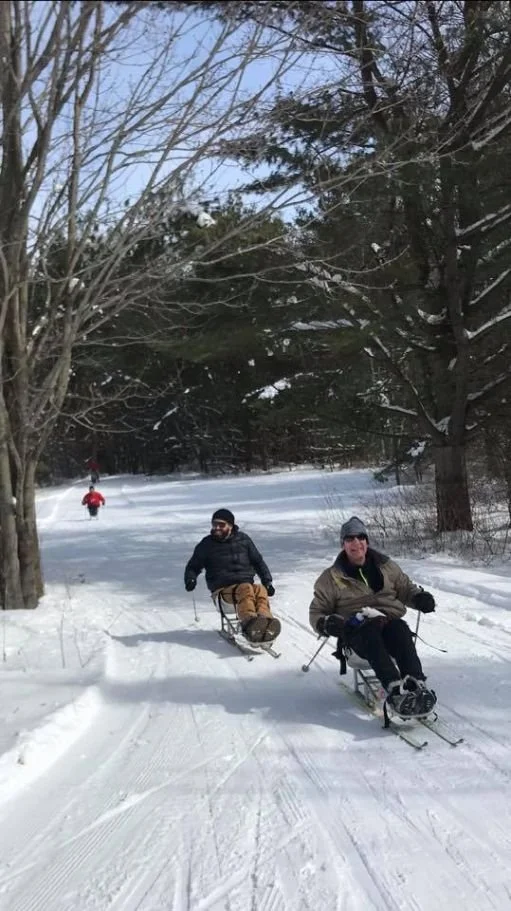XC skiing on a Sit ski
Nordic sit-skiing gives a taste of freedom to a person with mobility limitations to access snow covered trails, fields, and cross country (XC) ski areas that cover the north country. People such as wounded warriors, accident victims, or anyone born with mobility impairments (or even anyone who might prefer to sit) can experience the benefits of XC skiing…that is, getting outdoors in the natural environment, feel the confidence associated with physical and mental fitness and wellness, and enjoy the freedom to travel over snow as far as they can go.
Sit-skis are the adaptive equipment for folks in a wheel chair (spinal cord injuries) and for those with leg injuries, amputations, or anyone with or without a disability. There are different kinds of equipment designs to support a wide variety of users such as people with and without legs, people of different sizes, and so on. Sit-skiers use short poles in the range of 100-130 cm long. Those with one lower leg amputation are encouraged to participate in a standing position, so they might utilize the same equipment as able-bodied participants.
Sit-ski equipment consists of an ultra-light weight plastic or carbon fiber bucket supported by an aluminum alloy frame that clips into a pair of XC skis. The ski poles are shortened to accommodate the seat height and the skier double poles for a cross country ski experience.
So how much work is XC skiing for a mobility impaired person or someone who uses sit skis? The skis glide efficiently and the biggest challenge is steep hills. Most sit-skiers start on flat terrain and become accustomed to double poling to propel the equipment forward. Beginner trails at commercial XC ski areas provide optimal terrain for a sit-skier to practice and see if XC skiing is right for them. As in any endeavor, practice and repetition helps to develop the muscles and body parts that are needed. But the first time sit-skier should expect to have some arm soreness for a couple of days afterward.
It is a good idea to take a lesson and rent sit-ski equipment at the start to try it and see if XC skiing is something that feels right. There are dozens of different sit-ski designs with regard to attachment to the skis, and while there are only a few manufacturers of the equipment, more designs are being developed as more people get into it. Most sit-ski models now clip right on any XC ski binding while others bolt permanently and require tools to change skis. You would be able to change skis depending upon snow conditions if you have the clip-on model sit-ski. The length of the ski selected will vary based on the skier's weight and it is good to start beginners on shorter skis for easier maneuverability. A sit-skier wants to minimize the ski base friction and narrower skis are generally faster than wider skis.
Patrick Standen cross country skiing on a sit ski
There are only a few XC ski areas that have sit-ski equipment to use including Vermont's Rikert Nordic Center in Ripton and Craftsbury Outdoor Center which both have snowmaking, and Catamount Family Outdoor Center in Williston. Other areas with programs in the northeast include Pineland Farms in New Gloucester, Maine and Weston Ski Track in Mass. (both of these areas have snowmaking). Most often an introduction to sit-skiing is through programs. Such organized programs across the country are in Minnesota, Colorado, Wyoming, Utah, Oregon, and in Sun Valley, Idaho. Check XC ski areas in other regions to find out about adaptive XC ski programs.
A sit-ski beginner usually has his/her equipment prepared for him/her ahead of time by the instructor. A sit-skier applies downward pressure in order to move forward and wants to get everything lined up to make the movement efficient and take full advantage of their functioning muscles.
As you might imagine, hills are a challenge for sit-skiers and the key is to avoid steep uphill terrain. Backsliding on gentle terrain is less of an issue although on a steep incline there is always a point of no return. Since your sole source of energy is double-poling and you cannot side step or herring bone, you are at the mercy of physics and at some point you simply cannot climb. Beginning sit-skiers are taught a safety procedure for bailing out on a backwards descent.
Patrick Standen of the Northeast Disabled Athletic Association commented, "A person could chose whatever ski set up works best for them, their adapted equipment, and the terrain they use. I have some buddies who backcountry in the Sierra Nevada's, who sit-ski up mountains with skins, but they are seasoned skiers." In general, it is recommended that sit-skiers go out with a companion who can help push them up hills.
"Specifically, the double-poling motion and cadence changes as you approach and begin to climb hills by becoming shorter and more rapid until, if needed, you are "ice-picking" or pulling yourself up one carefully planted pole pull at a time. It can be arduous but it is a total upper body workout and a great cardio pump."
The Green Mountain Adaptive Sports program in Stowe, VT has a lesson program with trained instructors held at Craftsbury Outdoor Center with scholarships available for Vermont residents including equipment use for scholarship recipients (see the org website for application or more info).
Nordic skiing offers peace in the wilderness and feeds personal wellness and hopefully more persons with mobility impairments will discover that they can use ski-skis to attain this experience of beauty and tranquility.



